 Both Punxatawney Phil and our own local prognosticator, Staten Island Chuck, agree: six more weeks of winter. So I find myself stuck here in a series of cold fronts ― excuse me, make that “polar vortices” ― while bits and pieces of photo/art detritus accumulate like drifted snow. Here I offer some, as light refreshments before the next main meal.
Both Punxatawney Phil and our own local prognosticator, Staten Island Chuck, agree: six more weeks of winter. So I find myself stuck here in a series of cold fronts ― excuse me, make that “polar vortices” ― while bits and pieces of photo/art detritus accumulate like drifted snow. Here I offer some, as light refreshments before the next main meal.
Selfie Attacks of the Month
The rich get richer, and the poor get ― to view the selfies of the rich and their media suck-ups. Richard Quest, CNN’s international business correspondent and “presenter of Quest Means Business; the definitive word on how we earn and spend our money,” went to Davos, Switzerland in order to offer up a series of trenchant, toothy selfies posing with the wealthy, influential attendees at the World Economic Forum, as the outcome of his “selfie challenge.”
 Jon Stewart of The Daily Show described this annual event, where the rich wallow in luxury while contemplating the plight of those who don’t get to attend, as “frivolous and starfucky.” (This year’s Davos theme? “Global Inequality.” Redundant, if you ask me. Doesn’t this gathering of sufferers from “affluenza” exemplify that condition?) Stewart, bless his heart, asked of the press present there, “Are you financial journalists, or just excited to be invited to the Money Oscars?” Of whom could he possibly have been thinking? Questloot?, are your ears burning?
Jon Stewart of The Daily Show described this annual event, where the rich wallow in luxury while contemplating the plight of those who don’t get to attend, as “frivolous and starfucky.” (This year’s Davos theme? “Global Inequality.” Redundant, if you ask me. Doesn’t this gathering of sufferers from “affluenza” exemplify that condition?) Stewart, bless his heart, asked of the press present there, “Are you financial journalists, or just excited to be invited to the Money Oscars?” Of whom could he possibly have been thinking? Questloot?, are your ears burning?
•
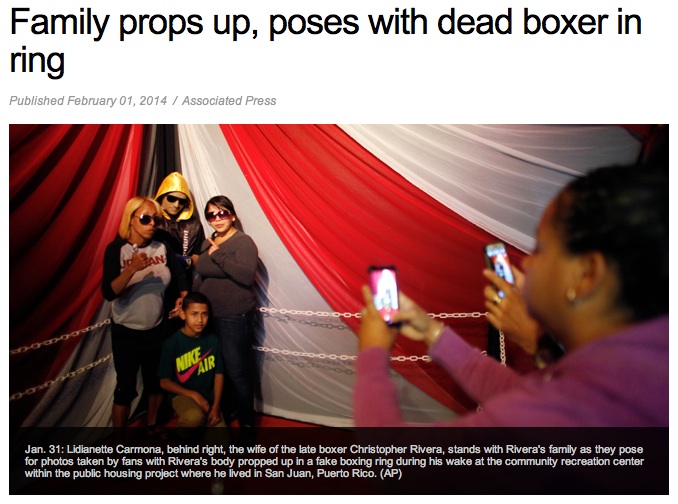
Christopher Rivera, wake, San Juan, Puerto Rico, 1-31-13. Fox News screenshot.
Meanwhile, another example of why I stopped writing fiction (because you can’t make this stuff up): The Selfies at Funerals website obviously spoke too soon in declaring POTUS Obama’s selfie at the Nelson Mandela celebration the ultimate in its class. The Mandela event ― complete with its clueless “interpreter” for the deaf waving his arms around meaninglessly for hours ― wasn’t even a funeral.
Now comes the “thematic wake” of murdered Puerto Rican boxer Christopher Rivera Amaro, held at the community center of a San Juan public housing complex on January 31. Rivera had expressed a wish to have “his boxing career acknowledged at his funeral” (he’d won 5 of his 20 fights). At the family’s request, a local funeral home helped “memorialize” him by presenting him there in the flesh, in his boxing outfit, standing up in a makeshift boxing ring, so that mourners could make selfies with him.
The bar for Puerto Rican surrealist performance art just got raised. Eat your heart out, Adál Maldonado.
Faux-Folksiness
Watching Obama’s State of the Union address on January 28, I found myself wondering just exactly when and how “folks” became the generic substitute for “people.” POTUS used it that way three times during that SOTUA ― e.g.,
” … So she dialed up what we call an American Job Center – places where folks can walk in to get the help or training they need to find a new job, or better job. … [W]hile the stock market has doubled over the last five years, that doesn’t help folks who don’t have 401ks. That’s why, tomorrow, I will direct the Treasury to create a new way for working Americans to start their own retirement savings: MyRA. It’s a new savings bond that encourages folks to build a nest egg.” (Emphasis added.)
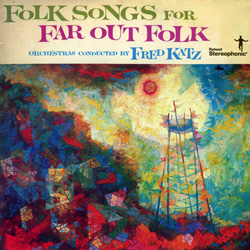
Fred Katz, “Folk Songs For Far Out Folk” (1959), cover
This now gets used commonly as a one-size-fits-all collective noun, applied indiscriminately to our own senior citizens, Middle Eastern terrorists, Latin American drug-cartel operatives, Russian homophobes, and both perpetrators and victims of the latest school shooting, regardless of its informal, affectionate connotations. Back in ’08, the pseudonymous michele2 at The Daily Kos pinned the introduction into political discourse of this amiable, low-key catch-all on Dubya, with his all-hat-and-no-cattle born-again-Texan act, on July 4, 2002. Seems plausible to me; I don’t recall its widespread use preceding that occasion. But such pretense to countrification ill behooves a president who’s spent most of his life in the urban world. Time for him to cease and desist deploying this Bushism, which won’t endear him to the folks in the red states in any event.
Father of the Cheezburger

“Walter Chandoha’s Book of Kittens and Cats” (1963), cover.
If you want to single out any individual to praise or blame as the instigator of the cute-cat motif that not only pervades the internet (through such sites as I Can Has Cheezburger and YouTube) but sparked a video festival and underpins a publishing industry that just can’t get enough cat books, cat calendars, and other feline-themed peripherals, I nominate Walter Chandoha, who’s peddled such imagery since the late 1940s ― close to seven decades. That’s more awwwwwwwww! and squee! than most people pack into a lifetime, and no one did more than Chandoha to spread it virally (mostly in the print era, though he’s still at it).
You can read Dean Brierly’s 2011 interview with Chandoha (from Brierly’s valuable website Photography Speaks), and watch a January 24, 2014 New York Times video profile of him as well. Whatever you think of his work, and his subject matter, Chandoha has not only survived but thrived as a freelance photographer all these years. Clear evidence that choice of area of specialization makes all the difference in freelancing, which tells me exactly where I went wrong . . .
It Ain’t Me, Babe
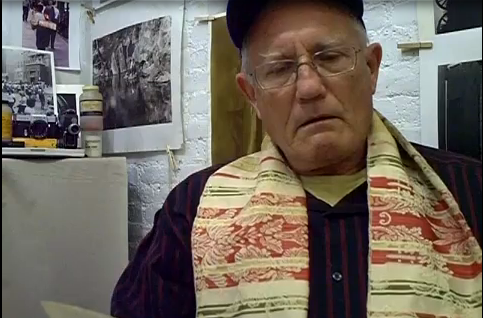
Chris Brant as A. D. Coleman, video by Alex Harsley, 10-10-13, screenshot
On October 10, 2013, my friend and colleague Alex Harsley posted at YouTube a video of Chris Brant, heretofore unknown to me, reading extracts from a May 8, 1973 interview that Alex conducted with me for a small-circulation newsletter published for several years by Minority Photographers, Inc., the non-profit organization that Alex founded in 1971 and still runs out of the 4th Street Photo Gallery, a storefront showcase he opened on East 4th Street in Manhattan.
At the time, I lived just two blocks east of the gallery, at 229 E. 4th St., in Alphabet City. So Alex and I were neighbors. In early ’73, after I resigned from the Village Voice in a censorship dispute, Alex (alone in what we then called the “photo community”) considered that significant enough to warrant an inquiry. So he asked for an interview, and I happily obliged. He came to my street-level loft space and audiotaped me there, then transcribed, edited (lightly), and published the results.
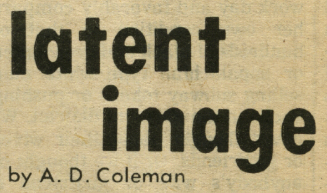
“Latent Image” column logo, Village Voice, ca. 1968.
Brant, wearing a New York Yankees baseball cap and what looks like a tallit, does a reasonably good job of reading (for the video camera) an almost 18-minute-long chunk of the interview and Alex’s preamble thereto, presumably without rehearsal. Harsley appears to have recorded his performance in the 4th Street Photo Gallery, about as close as he could reasonably get to the site on which we had those exchanges some 40 years earlier. Unless Alex is somehow housing trained seals in the gallery’s compact and already crowded space, the audio has some persistent problems.
I had no advance notice that they’d made this video, or that he’d posted it online; I chanced upon it during a search for something else. As I wrote to Alex in an email, I’d hoped that Sal Mineo would play me in the movie (until his passing, in any case), and would gladly play myself in a reenactment ― preferably with better audio. That may happen. In any event, later this year I’ll start on a compilation of my collected columns for the Voice, and I plan to include that interview as a tailpiece. Meanwhile, this version may amuse those with an interest in the NYC photo scene back in the day.
Wetware Update
For years I’ve told people that those of my cohort don’t have memory problems or “senior moments” ― our models just come with smaller hard drives and less RAM. Seems some new evidence supports that proposition. See “The Older Mind May Just Be a Fuller Mind” by Benedict Carey in the January 27, 2014 New York Times.

Boreal toad photo courtesy Flickr/Creative Commons, J. N. Stuart
And, since I’m on the subject of age: In December I posted my response to BBC columnist Will Self’s accusation that the boomer generation (and, presumably, those war babies like myself who preceded them) constitute “a giant and warty toad squatting on the youth of our society.” Self points that finger at us because, instead of dying or at least retiring to Florida, we keep working, occupying employment slots that rightfully belong to the young.
This represents Self’s version of a theory known as “lump of labor” that has “maintained traction in the U.S., particularly in a climate of high unemployment. The theory dates to 1851,” according to Matt Sedensky’s AP report, “Are older workers taking jobs from young?” as published in USA Today on January 4, 2014. “One problem, many economists say: It isn’t supported by a wisp of fact,” Sedensky reports.
“‘There’s no evidence to support [the hypothesis] that increased employment by older people is going to hurt younger people in any way,’ said Alicia Munnell, director of the Center for Retirement Research . . . [E]conomists say the larger macroeconomic view gives a clearer picture: Having older people active and productive actually benefits all age groups, they say, and spurs the creation of more jobs.”
Without Whom, None
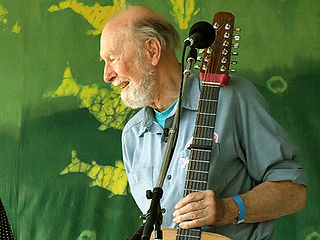
Pete Seeger at age 88, at the Clearwater Festival, June 16, 2007. Photograph by Anthony Pepitone, courtesy Creative Commons.
Speaking of warty toads: Musician and activist Pete Seeger died on January 27, at the age of 94, having performed into his 90s. I never much cared for Seeger’s music, and he stuck up for Uncle Joe way too long, but he made an enormous contribution to the preservation and promulgation of traditional folk music worldwide, which I respect. And I certainly admired his principled stance in opposition to McCarthy-era witch-hunting, his pro-labor and pro-environment commitments, and much else about him.
We also have a personal connection, though one of which he was entirely unaware for decades. My parents, both ardent Communists at the time, met at a Pete Seeger “hootenanny” in Greenwich Village in the early 1940s. No him, no me.

“The People’s Song Book” (1948), cover
In the fall of 1974 Seeger and his crew anchored the sloop Clearwater (dedicated to cleaning up the Hudson River) off the north shore of Staten Island, near my house, inviting local residents to come aboard for a tour, a concert, and a lecture. I bought tickets for myself and my then-girlfriend, who waited with me for the motorboat that would take us out to the ship.
To my astonishment, Pete himself picked us up and steered the outboard engine. Once we got underway, I told Pete that I owed him my life, leaving him nonplussed till I explained, which delighted him. I also told him that I still had my copy of The People’s Song Book, a 1948 collection of folk music and left-wing anthems that he’d had a hand in editing and publishing. I grew up singing a lot of those songs, some of which I still know by heart. I hadn’t thought to bring my copy along for him to sign, alas, but he believed me after I sang a verse of “Peat Bog Soldiers.”
Adios, Pete. Sine qua non.
•
This post supported by a donation from photographer Peter Kayafas.







As someone who has been around the groves of academe for half a century I take exception to the above. A case in point: there are more professors in the faculty of arts and sciences at Harvard who are over 60 than under 50. Colleges faculties in general are full of elderly dudes who could retire on a decent pension but hang around, protected by tenure and light teaching loads consisting of familiar courses.
At the more affluent universities, these codgers are served by the intellectual proletariat: graduate teaching assistants who do their grading and other routine work for them. If ancient professors would do the decent thing and step aside, perhaps to part time teaching, research, or book writing, they’d create openings for new Ph.D’s, often young people emerging from these professors own departments. Since these new faculty members would typically be paid 60% of the salaries of the aging “full” professors, one can safely say that when the buzzards step down they give their departments a cash gift.
A. David Wunsch
Emeritus Professor
University of Massachusetts, Lowell MA
No doubt there are specific areas of the economy that don’t conform to the “larger macroeconomic view.” Academe may be one. That doesn’t impeach the evidence on a bigger scale, just as our current deep freeze here in the northeast doesn’t disprove global warming.
So we can discuss the micro-situation of geezers entrenched in the ivory tower as an exception to the overall pattern economists note, without taking exception to their macro-observations.